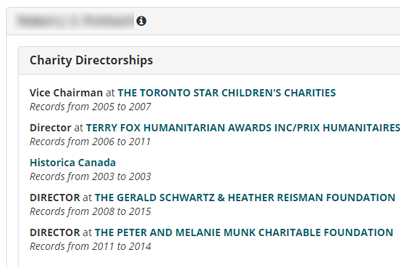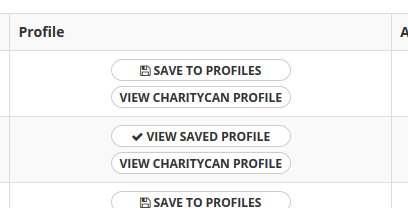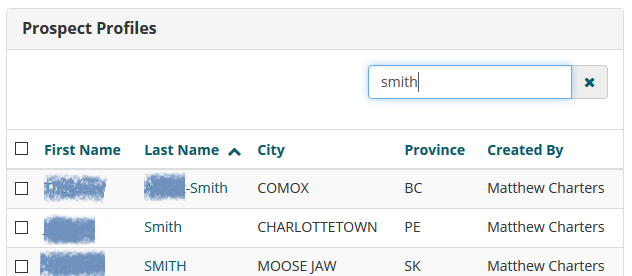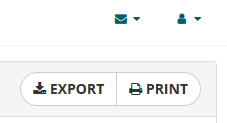by Matt Charters | Mar 12, 2018 | Features, Guide, News
Save, append, export, repeat
Today we’re announcing a new way of using prospect profiles in CharityCAN! Instead of just viewing our automatically created profiles, you can now save them to your own workspace for easy access for you and your team.
Once a profile has been saved to your workspace, you can start adding donation records search results to it to give your team a verified view into their giving history.
We’ve also added the ability to export any prospect profile, saved or otherwise, in a Microsoft Word document format, and improved the look of profiles when they’re printed directly from the website. This will let you get a headstart on your profile creation and make sure you’ll always have the most up-to-date information on a profile at your fingertips.
This is just the start of our work on personal prospect profiles, so stay tuned for more announcements!
The how-to
To save a profile, first search for a name in our Prospect Profile or Integrated search. You can add a profile by using the “Save to profiles” button directly from the search results table, or click “View CharityCAN profile” for a closer look. While viewing a CharityCAN-created profile, there will be another “Save to profiles” button that you can use.
Once a profile has been saved, it will be available in My Prospect Profiles for anyone on your team to view. You can filter saved profiles on the My Prospect Profiles page by searching by name or city.
You can append donation records to any saved profile anywhere you see donation record search results, either from Integrated search, the dedicated Donation Records search, or the results at the bottom of the profile itself. Select all the records you’d like to append and then click “Add to saved profile” at the top of the results table. Search for and select the profile you’d like to append the records to, and voila! You’ve now got verified donation records as a part of your saved profile.
To export a profile as a Word document, just click “Export” at the top of any profile page. You’ll get most of the profile details in a format that can be easily saved or modified offline.
We hope you find this new feature useful! If there’s more you’d like to see, or if you’d like a tutorial, please contact us. If you’re new to CharityCAN and want to see how these profiles can help your major gift pipeline, sign up for a free trial!
by Matt Charters | Jan 15, 2018 | News
We’re excited to announce that we’ve added a new, detailed corporate compensation data set to CharityCAN courtesy of Thomson Reuters. In addition to finding information on past corporate positions on individual donors, you can now use an integrated search to search and view detailed compensation breakdowns, positions and individual biographies for people all over North America.
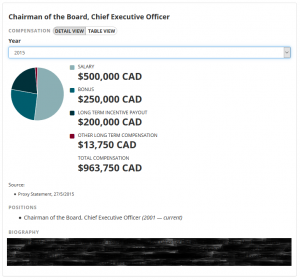
Example compensation breakdown
In the past, we were only able to show users a total compensation number for someone working at a public company. With this new data source we can now break down compensation by salary, bonus, short/long term compensation and in some cases, the sale of stock options.
Each corporate affiliation also contains a biography on the individual and a historical list of past positions at that organization, where available.
All the data is sourced from corporate filings required by regulators in Canada and the United States, but indexed and provided in an easy to read and digestible format.
We’ve also included these new compensation breakdowns in our prospect profiles where our algorithm has been able to match them up, so now it’s even easier to get a picture of someone’s capacity for giving at a glance!
This is just the first application of this new corporate data in CharityCAN, so stay tuned for further improvements!
Please get in touch if you have any questions about this new data set, or if you’d like a free trial to give it a spin!
by Matt Charters | Sep 11, 2017 | News
CharityCAN is pleased to let you know that there has been a major upgrade to our Corporate Canada data.
We now have data on senior executives of 9,371 public and private Canadian companies. This compares to 4,841 public companies for which previously we had data. This additional data is collected by Thomson Reuters.
Previously we were able to capture data on the named executive officers (typically five in number) and directors of publicly listed Canadian companies. We still have this data. But now we have data on additional senior managers at these companies.
Let’s take Bank of Nova Scotia as an example. We had data on five named executive officers plus the 16 directors of the bank. Now we have data on a total of 38 individuals, the 16 directors plus 22 senior executives. You can find information on employees of the Bank of Nova Scotia with titles such as: Executive Vice President and General Counsel, and Executive Vice President — Canadian Commercial Banking. While these folks are not earning eight-figure salaries of Canadian bank CEOs, you can rest assured they have salaries in the several hundred thousand dollar range, and perhaps higher.
For more local research, you can find corporate data on individuals by entering the name of your community in the City box on the Corporate Canada search page. Let’s use the example of Barrie, Ontario, a city of 130,000 located between where we are in Orillia, Ontario and Toronto. Previously we had data on the named executive officers and directors of the one public company located in Barrie: Student Transportation Inc. Now we also have data on individuals working for these three private companies in Barrie: CoCo Paving, Global Electric Electronic Processing, and gShift Labs Inc.
In total we have grown our Corporate Canada data points (a record of an individual at a particular company in a particular year) from 208,772 to 795,422 data points.
I doubt we could put on a number to how many Relationship Paths (who’s connected to whom; which of your charity’s directors can connect with prospects A, B, C …. etc.) can be generated in CharityCAN with our Corporate Canada data married to our Charity Director data.
Happy searching!
by Matt Charters | Sep 27, 2016 | News
We are pleased to announce to our subscribers a new major feature to the CharityCAN platform: Prospect Profiles featuring Relationship Mapping.
By aggregating records from across our Charity Director and Corporate Canada datasets, we have built algorithmic profiles of potential prospects that attempt to bring together in one place all the known CharityCAN records on an individual.
We’ve then used these new profiles to map out the connections between potential donors in a relationship graph on each profile page. You can easily see the top connections an individual has through public corporations or charity directorships and navigate quickly and easily through the graph to view more profiles for those connections, or to see that person’s connections.
Links to these new profiles are accessible wherever we can link a search result to a profiled individual, or via the new “Prospect Profiles” results tab in the integrated search.
To view a prospect profile/relationship map:
- Enter a name into Integrated Search
- Click on the “Prospect Profiles” tab
- Click on “View Profile” beside the name of the prospect
A note about common names: In some instances, you will see several Profiles for the name you have entered into Integrated Search. These profiles may indeed be for the same person. A few clicks should establish whether this is the case or not.
Please note that relationships are determined from historical data, as well as current records. Individuals who appear in relationship lists may no longer be involved with the organizations listed. In some cases they may also be deceased.
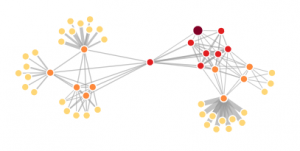
Example relationship graph
In the example graph above, the prospect is identified by the larger, dark red point. The prospects’ close relationships are identified by the red points, those individuals’ relationships identified by the orange points, and so on.
You can hover over any point in a Relationship Mapping graph to view details on the prospect it represents. Clicking on the point will pin the details to the graph for easy access. Clicking on the name of a charity or company then brings up relevant detailed information. You can also click and drag points around to easily explore other parts of the graph.
We hope you enjoy this new feature and look forward to building on it as we go forward. As always, we value your feedback so if you have any questions, comments or suggestions please contact us.
